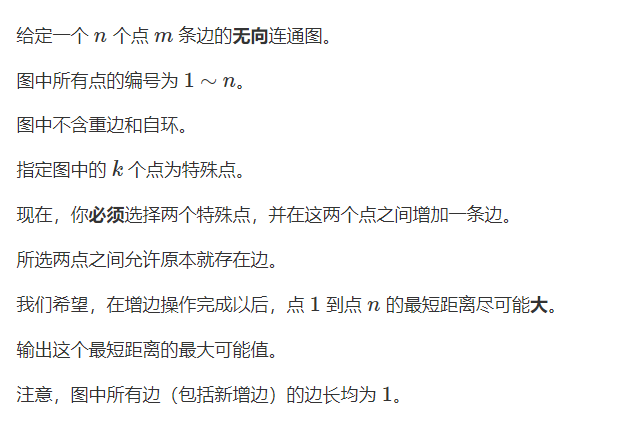题意:

思路:
首先说一些性质,比如我们操作a,b点,如果a,b不在1~n的最短路径上,那么对答案是没有贡献的。如果在1到n的最短路径上呢?也就是我们要求Max(dist[a]+dist2[b]+1),dist1代表从1开始bfs,dist2代表从n开始bfs最短路径,O(n^2)枚举肯定不好,我们可以按照dist[a]-dist2[a]排序一下,然后这个答案就可以O(N)枚举得到了,我们在枚举的时候记录一下最大的dist[x],当前的dist2[b]已经固定了,更新一下答案就好了,最后注意要和原本图的最短路取一个min。
// Problem: 最大化最短路
// Contest: AcWing
// URL: https://www.acwing.com/problem/content/3800/
// Memory Limit: 256 MB
// Time Limit: 1000 ms
//
// Powered by CP Editor (https://cpeditor.org)
#include<bits/stdc++.h>
#define IL inline
#define x first
#define y second
typedef long long ll;
using namespace std;
const int N=400010;
int h[N],ne[N],idx,e[N];
void add(int a,int b)
{
e[idx]=b,ne[idx]=h[a],h[a]=idx++;
}
int dist1[N];
int dist2[N];
int a[N];int n,m,k;
void bfs(int s,int dist[])
{
memset(dist,0x3f,4*N);
queue<int>q;
q.push(s);
dist[s]=0;
// cout<<s<<endl;
while(q.size())
{
auto t=q.front();
q.pop();
for(int i=h[t];~i;i=ne[i])
{
int j=e[i];
// cout<<t<<" "<<j<<endl;
if(dist[j]>dist[t]+1)
{
dist[j]=dist[t]+1;
q.push(j);
}
}
}
}
int main()
{
memset(h,-1,sizeof h);
cin>>n>>m>>k;
for(int i=1;i<=k;i++) cin>>a[i];
while(m--)
{
int a,b;
cin>>a>>b;
add(a,b);
add(b,a);
}
bfs(1,dist1);
bfs(n,dist2);
// for(int i=1;i<=n;i++) cout<<dist1[i]<<" ";
// cout<<endl;
int res=dist1[n];
// for(int i=1;i<=k;i++)
sort(a+1,a+1+k,[&](int a,int b)
{
return dist1[a]-dist2[a]<dist1[b]-dist2[b];
});
int ans=0;
int mx=0;
for(int i=1;i<=k;i++)
{
if(i>1)
ans=max(ans,mx+dist2[a[i]]+1);
mx=max(mx,dist1[a[i]]);
}
// cout<<res<<endl;
// cout<<ans<<endl;
cout<<min(ans,res)<<endl;
return 0;
}
最后
以上就是受伤衬衫最近收集整理的关于Cow and Fields(最短路思维)的全部内容,更多相关Cow内容请搜索靠谱客的其他文章。
本图文内容来源于网友提供,作为学习参考使用,或来自网络收集整理,版权属于原作者所有。








发表评论 取消回复